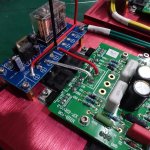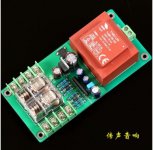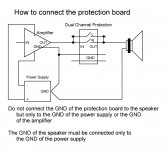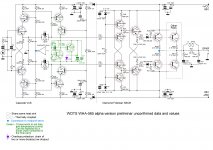1977 Studer A68
So the 108 seems to be a CFA. But the capacitors on the FB loop, in a CFA, should be avoided. Krell does.
krellname You laid out the nad 350 scheme with what intent?😕 It was my favorite, a year ago I sold it together with 521 CDs and now I have Dartzil.🙂
458 real schematic?
"Original circuit"? Is there, finally a schematic diagram for a real 458? Not a Guesstimate?My 458 "clone" is much better ( concernig the perceived sound ) than I expected.....but I only use the original circuit, original poor parts mainly, original internal synergy without any "improvement", etc....
"
@Hattori
I have just noticed a question in another post about single/dual speakers protection. Previous posts indicate that channels should be totally separated to elliminate hum. I have chosen separate mono protection boards to avoid possible hum. I have chosen this:

I have just noticed a question in another post about single/dual speakers protection. Previous posts indicate that channels should be totally separated to elliminate hum. I have chosen separate mono protection boards to avoid possible hum. I have chosen this:

The best simple solution is to use a dual channel protection for each channel, the two relays of each board must be put in parallel, not in series!!! The best overall is to remove the relay(s) on the protection board and use a 4 ways relay a channel with all 4 ways paralleled. For both solution you need two 12-:-17Vac separated secondaries.
I have added two of these to my shopping basket at Kathern Music:
Dual channel high current (16A*2) speaker protection board (integrated transformer version)|Amplifier| - AliExpress
Dual channel high current (16A*2) speaker protection board (integrated transformer version)|Amplifier| - AliExpress
Attachments
Last edited:
If you do not have two separate secondaries to feed the two protection boards, this is the only solution. Other dual channel board have better 30A relays but they don't have a transformer. So your choice is the right one. Connect the board following the schematic.
Attachments
Not sure this is the best connection regarding speaker safety. Might be better soundwise, tho 😎
good choice Hattori: this version doesn't need extra 15VAC supply. You can connect it directly to the mains (230 VAC). It has own transformer. You still can replace a single pole with two-pole relay of the same type/size to have connection suggested by Marigno. 🙂I have added two of these to my shopping basket at Kathern Music:
Dual channel high current (16A*2) speaker protection board (integrated transformer version)|Amplifier| - AliExpress
I may be wrong, but there are specific studies and examples that a serial connection of contacts is preferable. Garbage could better explain what this is connected with.🙄
Does anyone have a component list in digital form so it is easy to import in Digikey or Mouser? CSV, text, spreadsheet in any form, HTML? Old purchase orders you made for the components. I searched but could find one.
WOW ! what rails can be used with this if you want to bias AB?
2 X 36 vac transformer and it's 1500 W. I will not turn the bias high. I will keep it AB even if the heatsinks are big. 30 MV over each emitter resistor.
Common circuitry
Studying about the 108, the 458, and an old project by ing. Aloia (Superfinale - 1983), I could synthesize the whole experience in this WHA-565.
I posted it just to recall that this common topology is a well known and a very good one: the 108 has buffers preceding the two gain stages, the 458 is a minimalist approach, very simplified, without buffers and the Superfinale has two cascode gain stages, which, IMHO, is the best solution. There is a FB loop from the second gain stage to the first one. I'm sure a lot of amplifiers have the same topology for the gain stages.
The current gain stage is a diamond-triplet working in NSCB without any feedback, with a lot of pairs to achieve a good DF.
Going further, this theme would be off-topic. So I will not post anymore about it.
It will be a long way before hearing the WHA-565's sound, all component values must be verified and a PCB must be designed. Should anyone be interested, send me a pm.
Studying about the 108, the 458, and an old project by ing. Aloia (Superfinale - 1983), I could synthesize the whole experience in this WHA-565.
I posted it just to recall that this common topology is a well known and a very good one: the 108 has buffers preceding the two gain stages, the 458 is a minimalist approach, very simplified, without buffers and the Superfinale has two cascode gain stages, which, IMHO, is the best solution. There is a FB loop from the second gain stage to the first one. I'm sure a lot of amplifiers have the same topology for the gain stages.
The current gain stage is a diamond-triplet working in NSCB without any feedback, with a lot of pairs to achieve a good DF.
Going further, this theme would be off-topic. So I will not post anymore about it.
It will be a long way before hearing the WHA-565's sound, all component values must be verified and a PCB must be designed. Should anyone be interested, send me a pm.
Attachments
Studying about the 108, the 458, and an old project by ing. Aloia (Superfinale - 1983), I could synthesize the whole experience in this WHA-565.
I posted it just to recall that this common topology is a well known and a very good one: the 108 has buffers preceding the two gain stages, the 458 is a minimalist approach, very simplified, without buffers and the Superfinale has two cascode gain stages, which, IMHO, is the best solution. There is a FB loop from the second gain stage to the first one. I'm sure a lot of amplifiers have the same topology for the gain stages.
The current gain stage is a diamond-triplet working in NSCB without any feedback, with a lot of pairs to achieve a good DF.
Going further, this theme would be off-topic. So I will not post anymore about it.
It will be a long way before hearing the WHA-565's sound, all component values must be verified and a PCB must be designed. Should anyone be interested, send me a pm.
You reversed output pairs on the schematic..
Any point, at all, in building a 108?
Besides the brand name, the NHB model designation, the chassis color scheme and seriously high prices, do the 458 and 468 have anything in common with the NHB-108? Anything at all?
I did not push the Purchase button for NHB-108 PCBs and some other components (awaiting the end of the Chinese New Year holidays) Why should I even spend time and money ordering PCBs from China and eventually components at premium European distributor prices just to build an obsolete amplifier design?
Will your WHA-217 mod improve on the obsolete NHB 108 enough to make it a worth while project? Or should I hold out for the WHA-565?
Or simply buy an Accuphase clone pcb. Or...
Thanks for this clarification, Marigno!" the 108 has buffers preceding the two gain stages, the 458 is a minimalist approach, very simplified, without buffers and the Superfinale has two cascode gain stages, which, IMHO, is the best solution.
Besides the brand name, the NHB model designation, the chassis color scheme and seriously high prices, do the 458 and 468 have anything in common with the NHB-108? Anything at all?
I did not push the Purchase button for NHB-108 PCBs and some other components (awaiting the end of the Chinese New Year holidays) Why should I even spend time and money ordering PCBs from China and eventually components at premium European distributor prices just to build an obsolete amplifier design?
Will your WHA-217 mod improve on the obsolete NHB 108 enough to make it a worth while project? Or should I hold out for the WHA-565?
Or simply buy an Accuphase clone pcb. Or...
Last edited:
There are many different designs for an amplifier and none of them can be defined as obsolete. The three amplifiers I pointed out, being different designs, use the same topology. Other amplifiers use the differential/vas/buffer topology, the most widespread one; Quad uses another different topology, Hitachi very famous topology is from the mid-seventies, Cross coupled topology is an ancient one, very symmetrical (my favorite in tubes amps), etc.
Monotriode design is a very old one but still alive, Williamson design is dated 1947, Quad 405 is dated 1975, based on an older idea, still alive, used even with class A tube stage followed by the power block; OTL is an idea with different topologies and design. The best amp I heard is an OTL by SiAudio.
We cannot define obsolete any of the above designs/topologies. We would have no amplifiers today.
Then there are class D amplifiers but this is another story.
The main guideline I follow is the absence of feedback. You can achieve such an amplifier using very linear vacuum triodes. But with solid-state technology it is impossible, you have to use the feedback anywhere there is a voltage gain, with some exceptions in some preamplifier circuitry.
The chain I have in Italy is a tube one, has no feedback loop at all, two main amplifiers (10W and 20W), using a buffered cross-coupled stage, drive two B&W 801 in bi-amp. Old topology, new design (it's mine), able to return a very good sound.
So, have no concern about the age of the topology and design, everything needed was invented years ago.
The 108 shows a better design than the 458 (too simple one, strongly founded on feedback - I don't know the 468), the Superfinale (more or less the schematic I posted) is the most linear one and shows the best open-loop bandwidth that is an important parameter to consider. I didn't choose this last design because of the absence of a PCB, but this is the best of the three with the same topology.
I will never consider, as a HiFi amplifier, the one which has the feedback loop coming from the speaker output, no matter its fame, reputation, price. All amplifiers founded on differential/VAS/buffer topology with the feedback loop, if not too badly designed, they sound all the same. The LJM L20 V9.2 is a good example of this category, with a few mods you can drive it to the highest possible quality, that I did; it returns a good sound, very powerful and punchy, but it is not comparable to the WHA-217 sound that has no feedback loop from the output. The LJM L20 V10, same topology, is a worse design (a lot worse) but it sounds almost the same as the V9.2 one. Why? Because of the feedback loop.
That's my not humble opinion, for which I consider absurd to introduce an error which must be corrected afterward with the feedback applied at the last possible point, it is absurd to have a gain stage with an open-loop bandwidth of 10Hz, extended to 100KHz by applying the feedback.
That's me. There will be other different opinions and you have to choose the one you want to follow before starting a project, otherwise, you'll never hear a note!
The WHA-217 is the best you can do by yourself today, by easily modding an existing project; the WHA-565, by now, is only a design to be studied, verified, and needs a PCB. Don't wait for it, I will never have the time to carry it on, I have no instrument here, not sufficient skill by myself; I posted it hoping that some could be interested and start a topic in a different thread.
Monotriode design is a very old one but still alive, Williamson design is dated 1947, Quad 405 is dated 1975, based on an older idea, still alive, used even with class A tube stage followed by the power block; OTL is an idea with different topologies and design. The best amp I heard is an OTL by SiAudio.
We cannot define obsolete any of the above designs/topologies. We would have no amplifiers today.
Then there are class D amplifiers but this is another story.
The main guideline I follow is the absence of feedback. You can achieve such an amplifier using very linear vacuum triodes. But with solid-state technology it is impossible, you have to use the feedback anywhere there is a voltage gain, with some exceptions in some preamplifier circuitry.
The chain I have in Italy is a tube one, has no feedback loop at all, two main amplifiers (10W and 20W), using a buffered cross-coupled stage, drive two B&W 801 in bi-amp. Old topology, new design (it's mine), able to return a very good sound.
So, have no concern about the age of the topology and design, everything needed was invented years ago.
The 108 shows a better design than the 458 (too simple one, strongly founded on feedback - I don't know the 468), the Superfinale (more or less the schematic I posted) is the most linear one and shows the best open-loop bandwidth that is an important parameter to consider. I didn't choose this last design because of the absence of a PCB, but this is the best of the three with the same topology.
I will never consider, as a HiFi amplifier, the one which has the feedback loop coming from the speaker output, no matter its fame, reputation, price. All amplifiers founded on differential/VAS/buffer topology with the feedback loop, if not too badly designed, they sound all the same. The LJM L20 V9.2 is a good example of this category, with a few mods you can drive it to the highest possible quality, that I did; it returns a good sound, very powerful and punchy, but it is not comparable to the WHA-217 sound that has no feedback loop from the output. The LJM L20 V10, same topology, is a worse design (a lot worse) but it sounds almost the same as the V9.2 one. Why? Because of the feedback loop.
That's my not humble opinion, for which I consider absurd to introduce an error which must be corrected afterward with the feedback applied at the last possible point, it is absurd to have a gain stage with an open-loop bandwidth of 10Hz, extended to 100KHz by applying the feedback.
That's me. There will be other different opinions and you have to choose the one you want to follow before starting a project, otherwise, you'll never hear a note!
The WHA-217 is the best you can do by yourself today, by easily modding an existing project; the WHA-565, by now, is only a design to be studied, verified, and needs a PCB. Don't wait for it, I will never have the time to carry it on, I have no instrument here, not sufficient skill by myself; I posted it hoping that some could be interested and start a topic in a different thread.
- Home
- Amplifiers
- Solid State
- Dartzeel amp schematic - build this?




